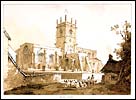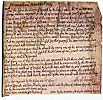|
Gnosall, St. Lawrence
Gnosall contains some of the finest Norman ecclesiastical architecture
in the county.
|
 This
wash drawing by T.P. Wood in 1838 shows the heavily buttressed north
chapel. This
wash drawing by T.P. Wood in 1838 shows the heavily buttressed north
chapel.
|
|
 The
interior view by John Buckler, 1841, shows the Norman tower arches
and upper gallery. The
interior view by John Buckler, 1841, shows the Norman tower arches
and upper gallery.
|
|
 Memorandum
relating to the fitting out of the loft by the pulpit for the use
of "persons singing psalms", 1729 Memorandum
relating to the fitting out of the loft by the pulpit for the use
of "persons singing psalms", 1729
Text Transcript
|
Longdon, St. James
Longdon still retains a number of Norman architectural features, including
the south doorway and the chancel arch.
|  The
Norman south doorway of Longdon church. The outer order with the
motif of circles is said to be rare. The
Norman south doorway of Longdon church. The outer order with the
motif of circles is said to be rare.
|
|  Interior view of the church showing the Norman chancel arch and
the original box pews. The Royal coat of arms is above the chancel
arch.
Interior view of the church showing the Norman chancel arch and
the original box pews. The Royal coat of arms is above the chancel
arch.
|
|
Tutbury, St. Mary
Originally part of the priory founded at Tutbury by Henry de Ferrers.
|
 This
engraving of a drawing by Stebbing Shaw, the Staffordshire antiquary,
shows the west door which is thought to date from c.1160-70. This
engraving of a drawing by Stebbing Shaw, the Staffordshire antiquary,
shows the west door which is thought to date from c.1160-70.
|
|

 Details
of the west door. The outer arch of seven orders is the first known
use of alabaster in England. Details
of the west door. The outer arch of seven orders is the first known
use of alabaster in England.
|
Stafford, St. Chad
A Norman church, St.Chad's was heavily restored in two phases in the
19th century but still retains its Norman nave and clerestory.
|  St.
Chad's from the north-east, as it appeared in 1822 before restoration. St.
Chad's from the north-east, as it appeared in 1822 before restoration.
|
|  Interior view of the north aisle of St. Chad's showing the heavy
Norman piers and multi-scalloped capitals.
Interior view of the north aisle of St. Chad's showing the heavy
Norman piers and multi-scalloped capitals.
|
Continue your tour in the 13th & 14th Centuries
>> or choose a time period from the Timeline at the top
of the page.
|



